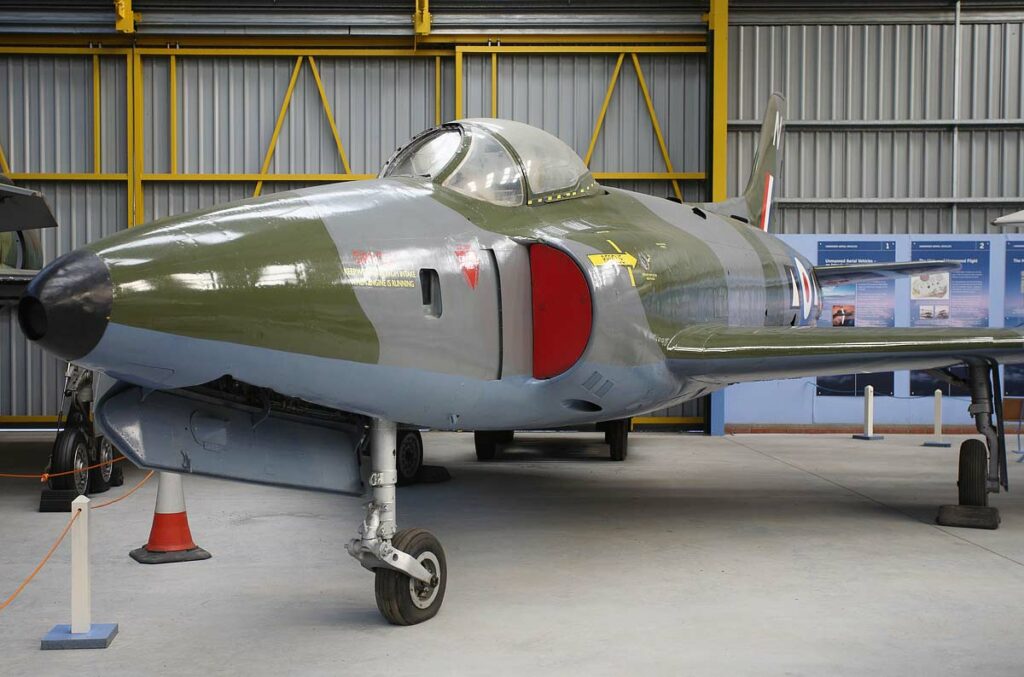The Supermarine Swift, a British early jet fighter, was known for its high speed and role as a transition into supersonic aircraft era.
In brief
The Supermarine Swift emerged as Britain’s venture into advanced jet technology during the early 1950s. Developed by Supermarine, the company famous for the Spitfire, the Swift was designed as a high-speed fighter and reconnaissance aircraft. It was propelled by a Rolls-Royce Avon turbojet engine, enabling notable speed and altitude capabilities. However, the Swift’s operational career was brief and troubled, overshadowed by design issues and the rapid advancement of jet technology. Despite setting several speed records and serving in frontline RAF squadrons, the Swift was soon eclipsed by more capable aircraft. Its legacy is mixed, but it remains a significant step in the evolution of British jet fighters, bridging the gap between early jets and the supersonic era.
The Supermarine Swift represents a crucial, albeit transitional, phase in the evolution of British military jet aircraft.
History of the Development of the Supermarine Swift
In the post-World War II era, the rapid advancement in aviation technology spurred the development of jet-powered aircraft. The Supermarine Swift was born out of this race for aerial superiority. It was developed by Supermarine, a company with a strong heritage in fighter aircraft design, notably the legendary Spitfire.
The objective was to create a high-speed, high-altitude jet fighter that could match or surpass the performance of contemporary Soviet aircraft. The program was launched in the late 1940s, with the first flight occurring on August 26, 1948.
The Swift did not have a specific NATO nickname, reflecting its primarily domestic operational use within the Royal Air Force (RAF).
Design of the Supermarine Swift
The design of the Supermarine Swift was innovative but ultimately flawed. It featured a swept-wing configuration, a characteristic of early jet fighters, and was powered by a Rolls-Royce Avon turbojet engine. The aircraft had a length of 12.19 meters (40 feet) and a wingspan of 11.13 meters (36.5 feet).
One of the key advantages of the Swift was its speed and altitude capability, initially promising for high-altitude interception roles. However, it faced design challenges, including stability issues and limitations in armament capacity.

Performance of the Supermarine Swift
The Supermarine Swift’s performance was a mix of high points and deficiencies. Its Rolls-Royce Avon engine provided a maximum speed of around 1,125 km/h (700 mph) and a service ceiling of 13,716 meters (45,000 feet). The range was limited, impacting its operational flexibility.
When compared to contemporaries like the Hawker Hunter and the North American F-100 Super Sabre, the Swift fell short in terms of reliability and overall performance. Its speed record achievements were notable, but in operational terms, it was outclassed by these more successful designs.
Military Use and Combat of the Supermarine Swift
The Swift’s armament included cannons and, in later versions, air-to-air missiles. Initially envisioned as a high-altitude interceptor, it was later adapted for reconnaissance roles due to its limitations in combat scenarios.
The Swift saw limited use in the RAF and did not participate in major conflicts. Its operational life was short, with the aircraft being withdrawn from frontline service relatively quickly. It was replaced by more capable and reliable aircraft like the Hawker Hunter.
The Swift was not extensively exported and remained largely a product of the RAF’s transition to more advanced jet fighters.
The Supermarine Swift, while not achieving the success of its predecessors or contemporaries, played a crucial role in the development of British jet aviation. It highlighted the challenges and complexities of early jet fighter design and paved the way for more successful future designs. The Swift’s legacy lies in its contribution to the understanding of high-speed jet flight and its role in the RAF’s transition into the supersonic age.
Back to the Fighter Jet section.